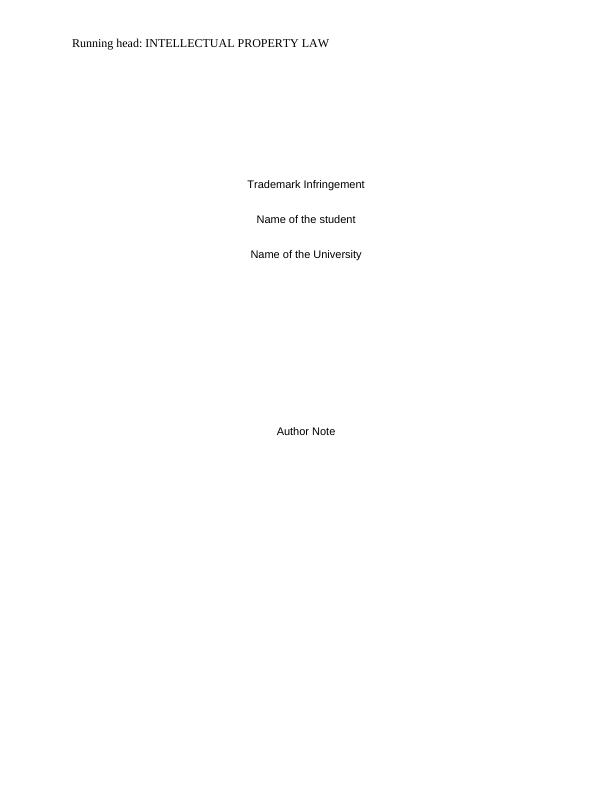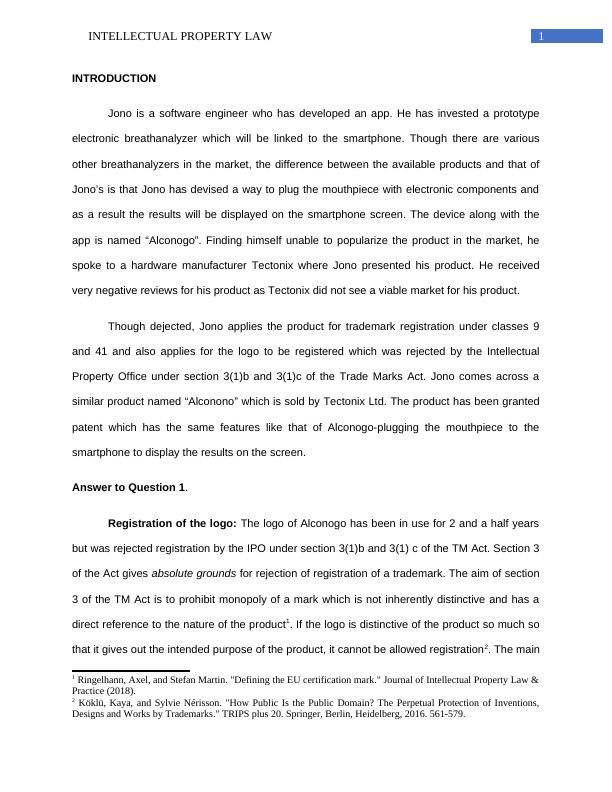Trademark Infringement in Intellectual Property Law
Added on 2023-06-14
10 Pages3158 Words157 Views
Running head: INTELLECTUAL PROPERTY LAW
Trademark Infringement
Name of the student
Name of the University
Author Note
Trademark Infringement
Name of the student
Name of the University
Author Note

1INTELLECTUAL PROPERTY LAW
INTRODUCTION
Jono is a software engineer who has developed an app. He has invested a prototype
electronic breathanalyzer which will be linked to the smartphone. Though there are various
other breathanalyzers in the market, the difference between the available products and that of
Jono’s is that Jono has devised a way to plug the mouthpiece with electronic components and
as a result the results will be displayed on the smartphone screen. The device along with the
app is named “Alconogo”. Finding himself unable to popularize the product in the market, he
spoke to a hardware manufacturer Tectonix where Jono presented his product. He received
very negative reviews for his product as Tectonix did not see a viable market for his product.
Though dejected, Jono applies the product for trademark registration under classes 9
and 41 and also applies for the logo to be registered which was rejected by the Intellectual
Property Office under section 3(1)b and 3(1)c of the Trade Marks Act. Jono comes across a
similar product named “Alconono” which is sold by Tectonix Ltd. The product has been granted
patent which has the same features like that of Alconogo-plugging the mouthpiece to the
smartphone to display the results on the screen.
Answer to Question 1.
Registration of the logo: The logo of Alconogo has been in use for 2 and a half years
but was rejected registration by the IPO under section 3(1)b and 3(1) c of the TM Act. Section 3
of the Act gives absolute grounds for rejection of registration of a trademark. The aim of section
3 of the TM Act is to prohibit monopoly of a mark which is not inherently distinctive and has a
direct reference to the nature of the product1. If the logo is distinctive of the product so much so
that it gives out the intended purpose of the product, it cannot be allowed registration2. The main
1 Ringelhann, Axel, and Stefan Martin. "Defining the EU certification mark." Journal of Intellectual Property Law &
Practice (2018).
2 Köklü, Kaya, and Sylvie Nérisson. "How Public Is the Public Domain? The Perpetual Protection of Inventions,
Designs and Works by Trademarks." TRIPS plus 20. Springer, Berlin, Heidelberg, 2016. 561-579.
INTRODUCTION
Jono is a software engineer who has developed an app. He has invested a prototype
electronic breathanalyzer which will be linked to the smartphone. Though there are various
other breathanalyzers in the market, the difference between the available products and that of
Jono’s is that Jono has devised a way to plug the mouthpiece with electronic components and
as a result the results will be displayed on the smartphone screen. The device along with the
app is named “Alconogo”. Finding himself unable to popularize the product in the market, he
spoke to a hardware manufacturer Tectonix where Jono presented his product. He received
very negative reviews for his product as Tectonix did not see a viable market for his product.
Though dejected, Jono applies the product for trademark registration under classes 9
and 41 and also applies for the logo to be registered which was rejected by the Intellectual
Property Office under section 3(1)b and 3(1)c of the Trade Marks Act. Jono comes across a
similar product named “Alconono” which is sold by Tectonix Ltd. The product has been granted
patent which has the same features like that of Alconogo-plugging the mouthpiece to the
smartphone to display the results on the screen.
Answer to Question 1.
Registration of the logo: The logo of Alconogo has been in use for 2 and a half years
but was rejected registration by the IPO under section 3(1)b and 3(1) c of the TM Act. Section 3
of the Act gives absolute grounds for rejection of registration of a trademark. The aim of section
3 of the TM Act is to prohibit monopoly of a mark which is not inherently distinctive and has a
direct reference to the nature of the product1. If the logo is distinctive of the product so much so
that it gives out the intended purpose of the product, it cannot be allowed registration2. The main
1 Ringelhann, Axel, and Stefan Martin. "Defining the EU certification mark." Journal of Intellectual Property Law &
Practice (2018).
2 Köklü, Kaya, and Sylvie Nérisson. "How Public Is the Public Domain? The Perpetual Protection of Inventions,
Designs and Works by Trademarks." TRIPS plus 20. Springer, Berlin, Heidelberg, 2016. 561-579.

2INTELLECTUAL PROPERTY LAW
element for registration of a trademark is that it should be distinctive but not descriptive. The
logo in question explicitly talks about drinking and driving, which is related to the function of the
app-breathanalysis which furthermore talks about drinking and driving. If the logo describes any
trait or characteristics of any product, it shall not be given registration because it designates the
quality of the product and cannot be registered.
Trademark Act 1994 grants exclusive rights to a trademark owner to prevent third parties
from infringing on their rights. Section 1 of the Trademark Act defines trademark as a mark
which can be graphically represented and which can be distinguished from one product to
another3. A mark includes a logo which can help in tracing the product to the source or the
producer.
When a product gives out information about its essence or worth through its logo, it is
said to have lost its idea of distinctiveness because it has used a mark which is already in the
public domain. The court refused the registration of the mark claiming that the logo gave out
enough information about the quality of the product and was not inherently distinctive. The logo
in the present case was a clear indication regarding the nature of the app because it showed an
image regarding prevention of drunk driving. Since the app was regarding breath analysis, the
logo can be said to be serving in trade to designate the functions of the product. The stance
taken by the court was on the similar ground that the logo of the app designates the function of
the app and there has lost its distinctive character that is essential while granting trademark4.
A mark shall not be refused registration on the grounds of section 3 of the TM Act if the
mark can show that it has acquired distinctiveness through prior use and the mark has been in
the mark for a significant time to acquire distinctiveness and the public can relate to the product
3 Tushnet, Rebecca. "What's the Harm of Trademark Infringement." Akron L. Rev. 49 (2016): 62
4 Yen, Alfred C. "Intent and Trademark Infringement." Ariz. L. Rev. 57 (2015): i.
element for registration of a trademark is that it should be distinctive but not descriptive. The
logo in question explicitly talks about drinking and driving, which is related to the function of the
app-breathanalysis which furthermore talks about drinking and driving. If the logo describes any
trait or characteristics of any product, it shall not be given registration because it designates the
quality of the product and cannot be registered.
Trademark Act 1994 grants exclusive rights to a trademark owner to prevent third parties
from infringing on their rights. Section 1 of the Trademark Act defines trademark as a mark
which can be graphically represented and which can be distinguished from one product to
another3. A mark includes a logo which can help in tracing the product to the source or the
producer.
When a product gives out information about its essence or worth through its logo, it is
said to have lost its idea of distinctiveness because it has used a mark which is already in the
public domain. The court refused the registration of the mark claiming that the logo gave out
enough information about the quality of the product and was not inherently distinctive. The logo
in the present case was a clear indication regarding the nature of the app because it showed an
image regarding prevention of drunk driving. Since the app was regarding breath analysis, the
logo can be said to be serving in trade to designate the functions of the product. The stance
taken by the court was on the similar ground that the logo of the app designates the function of
the app and there has lost its distinctive character that is essential while granting trademark4.
A mark shall not be refused registration on the grounds of section 3 of the TM Act if the
mark can show that it has acquired distinctiveness through prior use and the mark has been in
the mark for a significant time to acquire distinctiveness and the public can relate to the product
3 Tushnet, Rebecca. "What's the Harm of Trademark Infringement." Akron L. Rev. 49 (2016): 62
4 Yen, Alfred C. "Intent and Trademark Infringement." Ariz. L. Rev. 57 (2015): i.

End of preview
Want to access all the pages? Upload your documents or become a member.
Related Documents
Implementation of Intellectual Property Rightslg...
|7
|1457
|486
Evaluation of Civil Protection Provided by Trademark Lawlg...
|21
|7954
|40
E COMMERCE LAW E COMMERCE LAW 4 E Commerce Law Name of the Student Name of the University Author note To, Google 123 Main Street, Durban, KZNlg...
|6
|1331
|228
Intellectual Property Law - Case Studylg...
|15
|3869
|23
Trademark Protection in Singaporelg...
|8
|2555
|193
Intellectual Property Law: Scope of Protection for Registered and Unregistered Designs in the UKlg...
|14
|5411
|432
